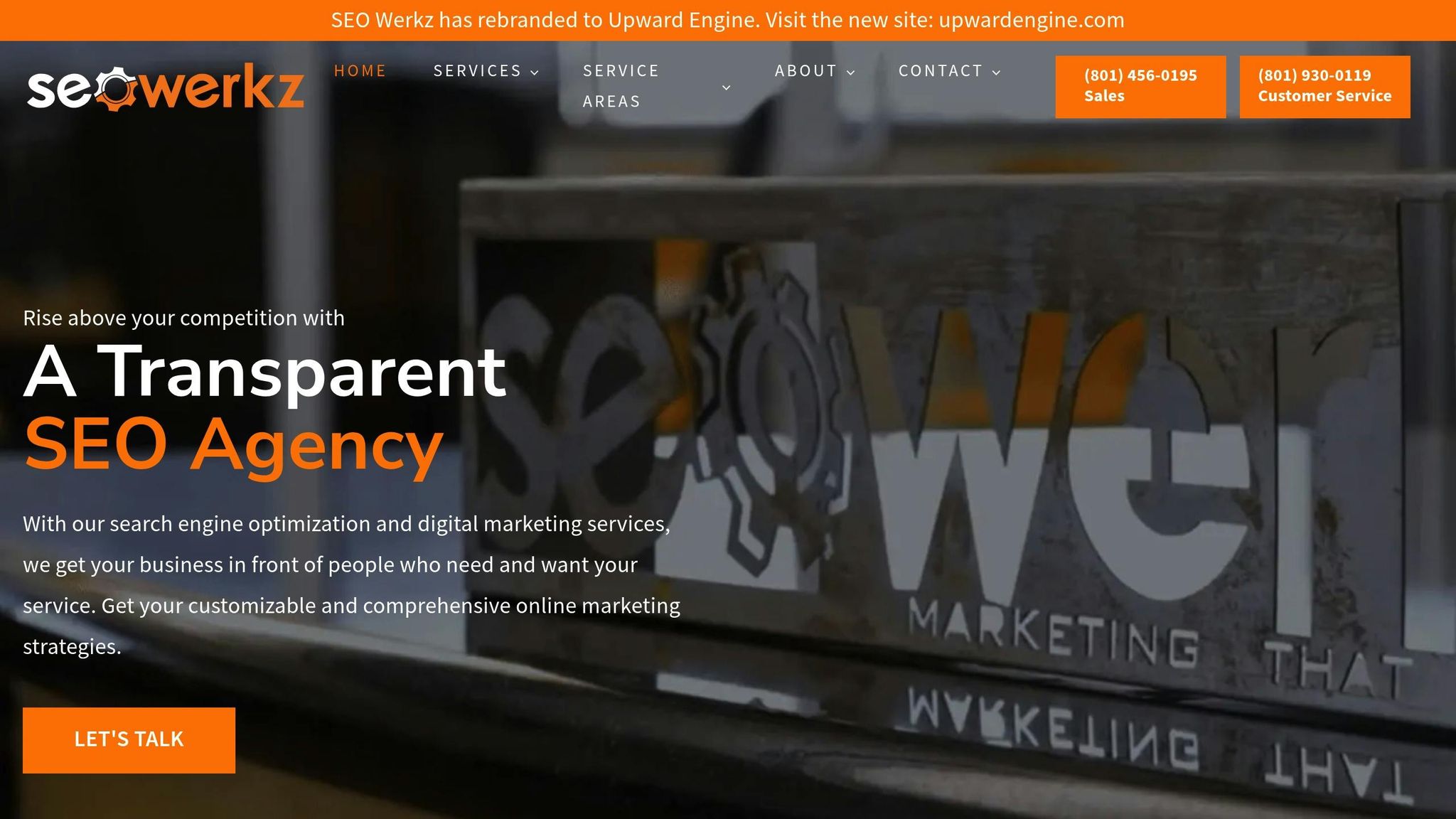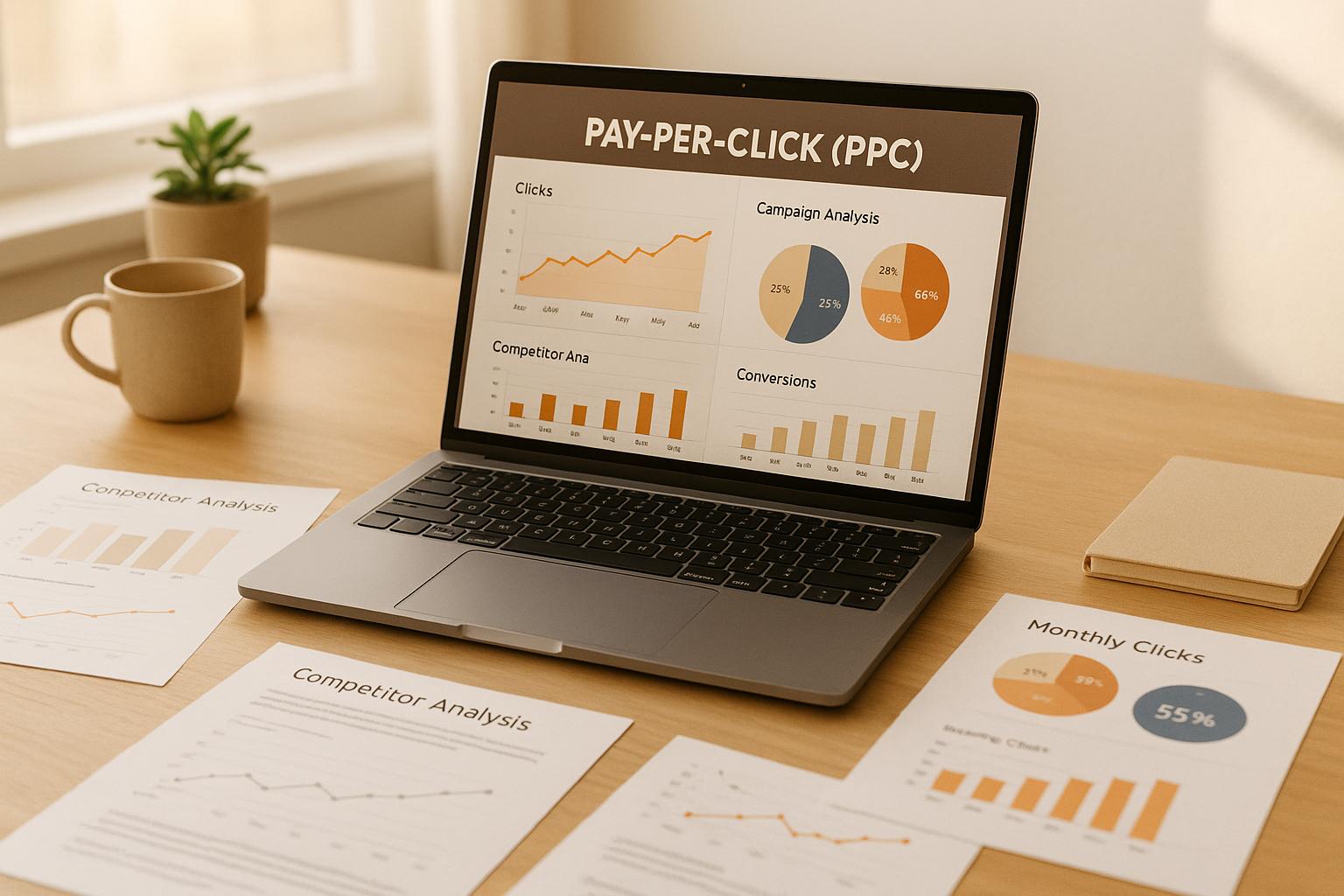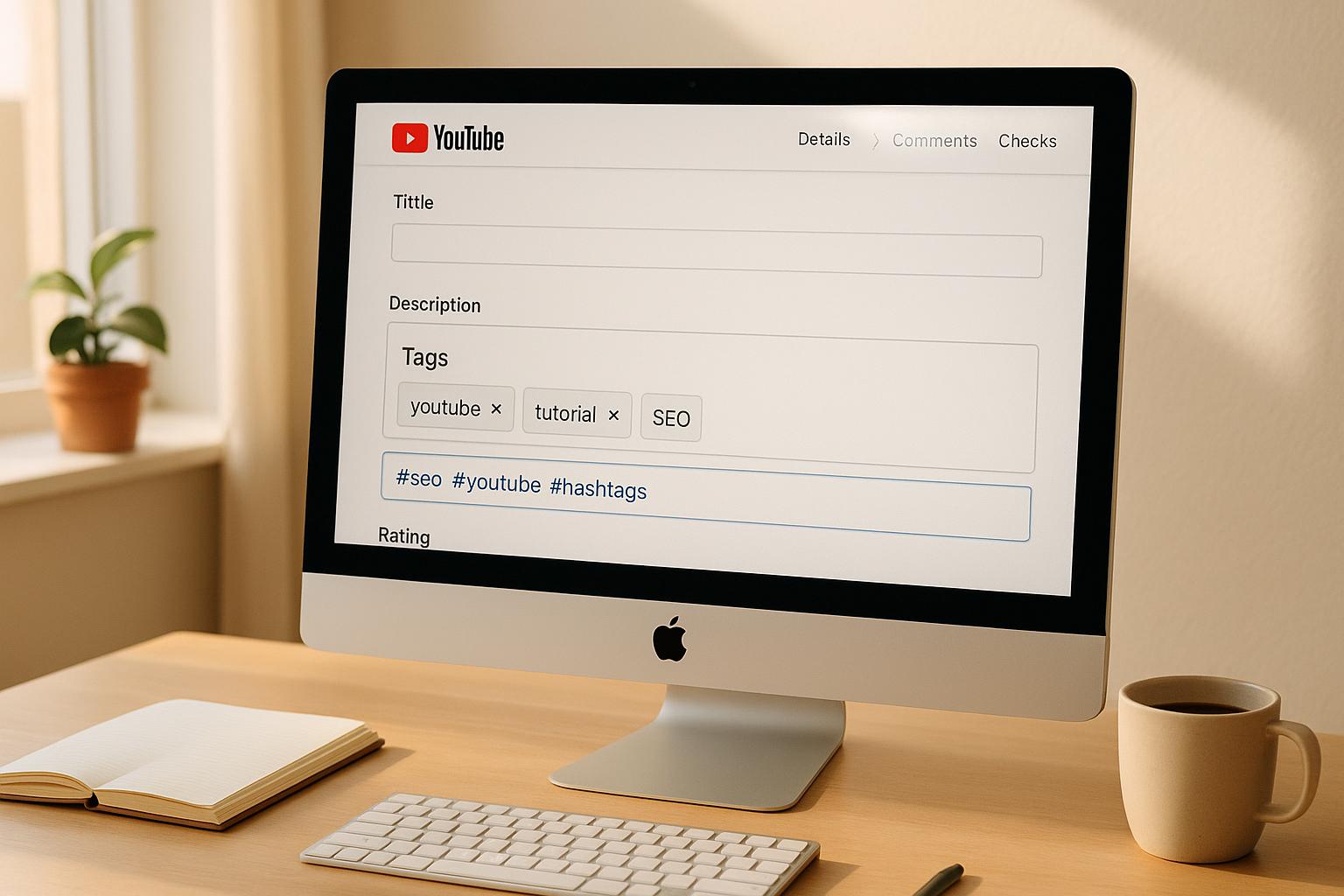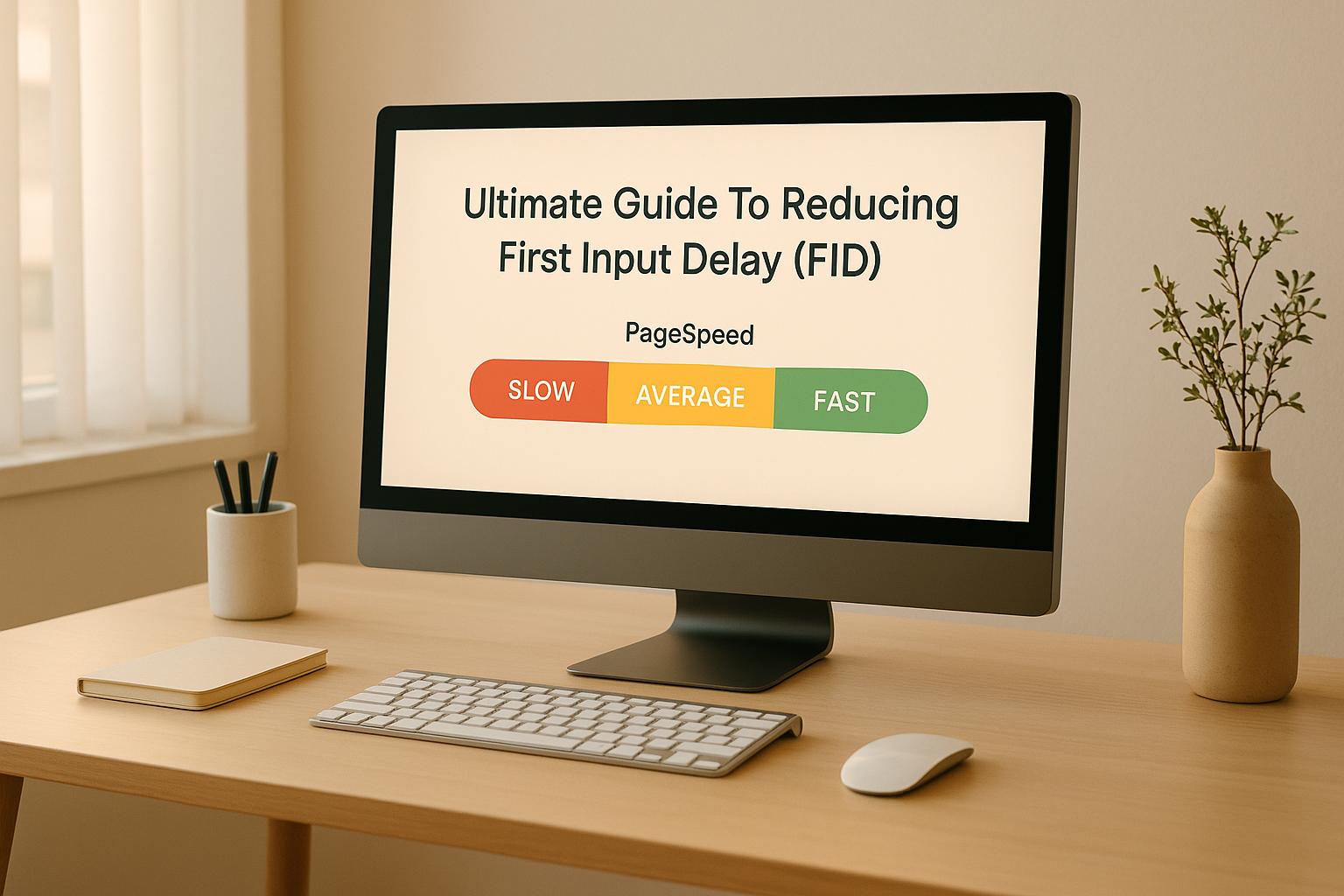How to Analyze Competitor PPC Campaigns
September 22, 2025Analyzing competitor PPC campaigns can help you improve your ad performance by learning from others' successes and mistakes. Here's a quick breakdown of how to do it effectively:
- Identify competitors: Look beyond direct competitors to include affiliates, resellers, and comparison sites targeting your audience.
- Keyword strategies: Use tools like SpyFu or SEMrush to find the keywords competitors bid on, especially long-tail and high-converting terms.
- Ad copy and landing pages: Study headlines, descriptions, CTAs, and landing page designs to see what resonates with your audience.
- Ad scheduling and bidding: Track when competitors run ads and adjust your strategy to target less competitive times.
- Performance metrics: Use tools like Google Ads Auction Insights to compare impression share, CTR, and other key metrics.
- Budget insights: Estimate competitors’ ad spend by observing ad frequency and placement patterns.
Quick Comparison
| Aspect | What to Analyze |
|---|---|
| Competitors | Direct, indirect, affiliates, resellers, and comparison engines |
| Keywords | High-performing, long-tail, branded, and seasonal terms |
| Ad Copy | Headlines, descriptions, CTAs, and recurring themes |
| Landing Pages | UX, mobile optimization, clarity, and alignment with ad promises |
| Ad Schedules | Time of day, days of the week, and seasonal trends |
| Performance Metrics | CTR, impression share, top-of-page rate, and outranking share |
| Budget Allocation | Ad frequency, geographic targeting, and seasonal patterns |
How To Run A Competitor Analysis For PPC
How to Find Your Key PPC Competitors
Identifying your PPC competitors goes beyond just listing the usual players in your industry. The businesses bidding on the same keywords as you may not always be your direct competitors. Affiliates, resellers, and comparison shopping platforms often compete for the same audience, making the PPC landscape more complex than it seems.
Start by searching for your most important keywords at different times of the day and week. Pay attention to the ads that consistently show up at the top of the search results - these advertisers are likely spending heavily and should be your primary focus for analysis.
Don’t stop at the obvious. For instance, if you’re a software company offering project management tools, you might find yourself up against freelance consultants, blogs with affiliate links, or comparison sites - all targeting the same audience in different ways.
How to Group Different Types of Competitors
"Not all competitors are created equal. Breaking your competition into clear segments - direct, indirect, affiliates, and resellers - creates a sharper, more strategic foundation for your analysis." - SpyFu
Here’s how you can categorize competitors and what to look for:
- Direct competitors: These businesses sell the same products or services to the same audience. They’re your most immediate rivals. Study their ad schedules, landing page strategies, and budget allocation to see how they’re reaching your shared audience.
- Indirect competitors: These solve the same problem but with different products or services. For example, a meal delivery service might compete indirectly with grocery stores, cooking apps, or restaurant platforms. Analyze their keyword strategies to find opportunities to reach users earlier in their decision-making process.
- Affiliates and marketing partners: These advertisers promote competitors' products for commissions. They often bid aggressively on keywords and use comparison-heavy ads and landing pages.
- Resellers and distributors: These businesses sell competitors' products, often bundling them with additional services or targeting specific customer segments. Watch their local targeting strategies and bundled offerings.
- Comparison shopping engines: Platforms like Google Shopping and Amazon aggregate multiple products, dominating high-intent keywords with their massive budgets. Understanding their pricing strategies and product feed optimizations can help you compete.
| Competitor Type | Strategic Implication for PPC |
|---|---|
| Direct Competition | Focus on outranking them for shared keywords, differentiating ad copy, and optimizing landing pages. |
| Indirect Competition | Target problem-related keywords to capture users earlier in their decision-making process. |
| Affiliates & Partners | Monitor their commission-driven bidding patterns and promotional strategies. |
| Resellers | Watch for local targeting and bundled offerings. |
| Comparison Engines | Study their product feed optimizations and pricing to stay competitive. |
Using Search Engines to Find Competitors
Search engines are a great tool to uncover your competitors in action. Your search results can vary by device, location, and even time of day, so it’s important to segment your research for a complete picture.
- Search across devices: Ads that perform well on desktop may not translate to mobile. Check both to spot differences in competitor strategies.
- Search at different times: Advertisers often adjust budgets based on performance data, so you might see different competitors during peak and off-peak hours. Take screenshots to track changes over time.
- Explore keyword variations: Competitors may not bid on your exact terms but could target broader keywords, synonyms, or industry jargon. Don’t forget misspellings or related searches.
- Test different locations: Use VPNs or location-specific search settings to see how competitors vary by region. Local businesses might dominate in some areas, while national brands focus on others.
Finally, pay attention to ad extensions, sitelinks, and other SERP features your competitors use. These elements can reveal their key landing pages, promotions, and overall campaign priorities.
How to Analyze Competitor Keyword Strategies
When conducting a thorough PPC competitor analysis, diving into competitor keyword research is a must. It not only uncovers profitable opportunities but also highlights keyword gaps that can help you expand your PPC campaigns and reach a broader audience.
This becomes increasingly relevant when you consider that 15% of Google searches every day are brand new. While you’re sticking to your tried-and-true keywords, your competitors might already be testing these new search terms. Regularly analyzing competitor keywords ensures your paid search strategies keep up with evolving customer search habits.
How to Find Competitor Keywords
Specialized PPC tools are your best friend when it comes to uncovering competitor keywords. These tools can reveal the keywords your competitors are bidding on, along with useful metrics like estimated costs per click, search volumes, and ad positions.
Start by entering your competitors’ domains into a keyword research tool. Look for keywords they consistently rank high for in paid ads. Focus on those with strong search volumes and manageable cost-per-click rates - these are often the sweet spot for expanding your campaigns.
Don’t overlook branded terms, which can give insight into defensive strategies, as well as non-branded terms, including long-tail keywords. Long-tail keywords, in particular, can drive high-intent traffic at a lower cost. Compare these findings with your current keyword list to spot gaps and uncover new opportunities.
How to Find Keyword Gaps and Opportunities
Keyword gap analysis is a powerful way to spot missed opportunities, reallocate your ad spend more effectively, and improve your campaign performance. To get started, compare your existing keyword list against the keywords your competitors are actively targeting. This comparison can quickly reveal areas where you’re missing out.
Pay attention to patterns in your competitors’ strategies. If multiple competitors are targeting the same keywords that you’re not, it’s a strong indicator that those terms are driving valuable traffic. On the flip side, if only one competitor is bidding on a specific keyword, take a closer look to determine whether it’s a hidden gem or if there’s a reason others are steering clear.
Look at both direct and indirect competitors. Direct competitors - those offering similar products or services - can reveal immediate threats and opportunities. Indirect competitors, who may target the same audience or solve similar problems, can help you uncover entirely new market segments. When analyzing gaps, consider the entire customer journey. For example, targeting awareness-stage keywords like "what is [product category]" or comparison terms such as "X vs Y" can help you reach potential customers earlier in their decision-making process.
How to Track Seasonal and Trend-Based Keyword Changes
Competitor keyword strategies are rarely static. They often shift in response to seasons, trends, and changing market conditions. To stay ahead, revisit your competitor analysis every 1-3 months. This helps you track seasonal trends and adapt your campaigns to align with evolving customer behaviors. By doing so, your keyword strategy remains dynamic and relevant, keeping you competitive in the ever-changing PPC landscape.
How to Review Competitor Ad Copy and Landing Pages
After identifying competitor keywords, the next step is to dive into their ad copy and landing pages. This process reveals how they connect with your shared audience and what messaging strategies are driving clicks and conversions. By analyzing these elements, you can uncover messaging techniques and unique selling points that you might have overlooked.
Tools like the Google Ads Transparency Center and Facebook Ad Library make this task straightforward. These platforms allow you to explore both active and historical ads from competitors, offering a window into their creative strategies and how they've evolved over time.
How to Analyze Ad Headlines, Descriptions, and CTAs
Building on your keyword research, focus on how competitors structure their messaging. Break down ad elements - headlines, descriptions, and CTAs - and categorize them to identify patterns in tone, value propositions, and urgency. Pay close attention to the tone, messaging, and offers used in their ads, as these can provide insight into what resonates with your audience.
For instance, a competitor might use phrases like "Get 20% Off Today" or "Book Your Free Consultation Now." These examples can highlight what type of language and urgency drives engagement in your industry.
Look for recurring themes and offers. If you notice multiple competitors emphasizing free trials or customer testimonials, it's a clear indication that these strategies are effective with your target audience. Additionally, track which ads appear most frequently in search results - those that consistently show up are likely performing well. You can adapt similar messaging for your campaigns while ensuring it aligns with your brand voice.
How to Evaluate Landing Page Quality
Click through competitor ads to assess their landing pages. Evaluate their clarity, load speed, mobile responsiveness, and whether they deliver on the promises made in the ad. This process can reveal opportunities to improve your own conversion strategies.
Key elements to review include user experience (UX), page load speed, mobile optimization, and alignment between the ad's promise and the landing page content. For example, if an ad promises a free trial, the landing page should make it easy to claim that offer with a clear and prominent call-to-action.
Strong landing pages often feature clear headlines, concise benefit statements, social proof like testimonials, and minimal distractions. They might also include trust-building elements like security badges, contact information, and bold CTAs. On the other hand, weak landing pages tend to have cluttered layouts, unclear messaging, or fail to deliver on the ad’s promise.
One SaaS company noticed that competitors frequently used "Free Trial" CTAs and showcased customer testimonials on their landing pages. By adopting a similar "Start Your Free Trial" CTA and adding real customer reviews to their own page, they achieved a 15% increase in conversion rates over two months.
This example shows how adapting proven strategies while staying true to your brand can yield measurable results. Once you've analyzed ad copy and landing pages, it's time to focus on ad extensions and creative elements.
How to Review Ad Extensions and Creative Variations
Ad extensions add extra information to search ads, such as sitelinks, callouts, phone numbers, or structured snippets. These elements can significantly boost an ad's visibility and click-through rates. Use ad transparency tools to monitor how competitors utilize extensions and experiment with similar or improved versions in your campaigns.
Pay attention to how competitors use sitelinks to highlight key offerings like "Pricing", "Testimonials", or "Free Demo." Callout extensions, which emphasize selling points like "24/7 Support", "Free Shipping", or "Money-Back Guarantee", can also make ads more engaging and informative.
Analyzing creative variations is equally important. Ad transparency tools can help you understand competitors' A/B testing strategies and pinpoint which elements - such as images, colors, or copy styles - are resonating with your shared audience. Seasonal variations are another factor to watch. Many businesses adjust their messaging, offers, and visuals around holidays, industry events, or market trends. Tracking these shifts can help you anticipate competitor moves and plan your own campaigns accordingly.
Finally, use metrics like impression share, overlap rate, position above rate, top of page rate, and outranking share from Google Ads Auction Insights. These figures provide a clearer picture of not just what competitors are doing, but how effective their efforts are compared to yours.
sbb-itb-cef5bf6
How to Compare Competitor Performance and Budget Allocation
Understanding how your competitors allocate their budgets and measure performance can give your PPC strategy a serious edge. By analyzing their spending habits and performance data, you can identify opportunities in the market and fine-tune your campaigns.
How to Estimate Competitor Budgets and Ad Spend
Estimating a competitor's budget isn't a one-step process - it requires pulling together data from different sources and using a bit of detective work. Start by observing how often their ads appear throughout the day and across various search terms. If their ads consistently show up in top positions during peak times, it's a good sign they're investing heavily.
Tools like Google Ads Auction Insights can provide valuable data on competitor performance. For example, the impression share metric reveals the percentage of available impressions an ad captures, offering clues about how much they might be spending. Comparing metrics like search impression share and display impression share can also help you understand how they allocate their budget across different campaign types.
Pay attention to seasonal trends. Many businesses adjust their ad spend during key periods - think retailers ramping up before major sales events, seasonal service providers increasing budgets during their busiest times, or B2B companies spending more toward the end of a fiscal quarter. Geographic targeting is another telltale sign of budget size. Competitors focusing on high-cost regions like New York City or San Francisco likely have larger budgets than those targeting smaller or less competitive markets.
Once you've estimated their spending, shift your focus to performance metrics to assess how effective their campaigns are.
How to Compare Performance Metrics
After estimating your competitors’ budgets, the next step is to evaluate how well their campaigns perform. Metrics like high click-through rates (CTR) and frequent top-of-page placements often indicate strong ad engagement. Tools like the Google Ads Transparency Center can help you dive into these metrics. If a competitor's ads are consistently visible, it’s a sign they’re resonating with their audience and are likely optimized for success.
Some key performance indicators to monitor include:
- Average position and top-of-page rate: These metrics, available through Auction Insights, shed light on their bidding strategies and how effectively they’re using their budget.
- Impression share trends: Changes over time can signal shifts in budget or performance. A rising impression share might mean they're increasing their spend or improving ad quality, while a decline could suggest budget cuts or underperforming campaigns.
- Overlap rate and outranking share: These metrics reveal how often your ads compete directly with theirs and who’s coming out on top.
You can also analyze device and demographic data. For example, if their ads are more visible on mobile devices or during specific times of the day, it might highlight areas where they’re focusing their efforts - and where you can refine your strategy.
How to Track Ad Scheduling and Bidding Patterns
Ad scheduling offers a glimpse into when competitors believe their audience is most active and valuable. By tracking when their ads appear throughout the day and week, you can uncover their scheduling strategies and gain insights into their priorities.
For example, B2B companies often bid higher during standard business hours, while e-commerce brands might focus on evenings when consumers are more likely to shop. Identifying these patterns can help you find less competitive time slots or decide when to adjust your own bids.
Day-of-week trends are also revealing. Competitors with strong weekday activity are likely targeting business audiences, whereas those focusing on weekends are probably aiming at consumers. Industry-specific patterns also come into play - restaurants, for instance, might bid more on Friday afternoons, while B2B companies might scale back on weekends.
Seasonal trends provide even more context. Watching how ad frequency changes during holidays, industry events, or seasonal peaks can show when competitors are allocating extra budget to capture increased demand.
Finally, tracking daily ad visibility throughout the month can offer insights into how they pace their budgets. Competitors with smaller budgets often show strong ad presence early in the month but taper off as funds run low. On the other hand, those with larger budgets maintain steady visibility. Use this information to your advantage - when competitors reduce their bids, it might be the perfect time to capture more visibility at a lower cost.
Tools and Reporting for PPC Analysis
Using the right tools and a solid reporting system can turn competitor data into actionable insights for your PPC strategy. The goal is to select tools that fit your budget and objectives, while organizing the data in a way that simplifies strategic decision-making.
Best Tools for Competitor Analysis
Building on earlier discussions about competitive data, the following tools can help transform raw insights into actionable strategies. PPC tools range from free resources to premium platforms that leverage advanced models.
- Google Ads Auction Insights: This free tool is essential for PPC campaigns, offering precise data directly from Google. It provides metrics like impression share, overlap rate, and outranking share, giving you a real-time view of how your campaigns stack up against competitors in shared keyword auctions.
- SpyFu: For $39/month, SpyFu provides access to over a decade of historical PPC data. It allows you to track changes in competitor ad copy, keyword strategies, and budgets, helping you identify long-term trends and successful campaigns.
- SEMrush: Starting at $139.95/month, SEMrush combines PPC data with SEO and content insights, making it ideal for teams managing integrated marketing efforts.
- PPC.io: This platform offers a free tier with credits and scales to $99+/month. It uses advanced models like Claude, GPT-4, and Gemini to create strategic plans and conversion-optimized alternatives, going beyond traditional data analysis.
- Bestever: Priced at $39/month for 300 credits, Bestever dives into competitor ad visuals, analyzing elements like color psychology, typography, and emotional triggers. These insights can be invaluable for crafting new ad variations.
- Meta's Facebook Ad Library: This free resource provides a database of all active ads on Facebook and Instagram, including remarketing campaigns. Pair it with MagicBrief ($29/month) for deeper analysis of social media ads and competitor strategies.
How to Organize and Display Your Findings
Competitor data is only useful when it’s structured in a way that highlights actionable opportunities. Start by creating dashboards that filter data by timeframe, campaign, or ad group. This helps you zero in on relevant threats and opportunities.
- AgencyAnalytics: At $59/month, this tool simplifies reporting by automatically highlighting key metrics, trends, and performance comparisons. It’s particularly helpful for presenting a clear overview of campaign performance with minimal effort.
When structuring your reports, focus on vital PPC metrics like Cost per Click (CPC), Click-Through Rate (CTR), Conversion Rate, Cost per Acquisition (CPA), and Return on Ad Spend (ROAS). Segment the data by device, location, and demographics to uncover where competitors are focusing their efforts - and where you might find untapped opportunities.
Timely updates are crucial. Refresh your analysis every 1–3 months, or monthly in fast-changing industries, to stay ahead of emerging trends. Automation tools can streamline routine data collection while maintaining consistency in your reporting. However, manual reviews remain essential for spotting nuanced insights that automated systems might miss.
How to Apply PPC Insights to Your Campaigns
With your data organized and insights in hand, it’s time to refine your PPC strategy. Start by analyzing your current ROI and cost-to-revenue ratios. This baseline will help you determine which competitor strategies align with your budget and performance goals.
Use competitor ad insights to shape your messaging and creative testing. For example, if analysis tools reveal that certain emotional triggers or visual elements drive competitor success, consider incorporating similar tactics into your ads. Adjust elements like call-to-action placement, color schemes, and messaging hierarchy to boost engagement.
Competitor spending patterns can also inform your budget allocation. If you notice competitors scaling back during specific times or in certain geographic areas, increase your bids during those periods to capture market share at a lower cost. Similarly, analyzing competitor landing pages can reveal opportunities for improving your conversion rates. Study their content structure, funnel designs, and user experience, then adapt successful elements to fit your brand.
Lastly, examine how competitors nurture leads from first interaction to conversion. Identifying gaps in your own funnel can help you create a smoother, more effective user journey, setting the stage for long-term success.
Conclusion
Digging into competitor PPC campaigns can give you a real edge in improving your own results. The step-by-step approach we’ve laid out here offers a clear path to staying ahead in the crowded world of digital advertising.
Key Takeaways from Competitor PPC Analysis
To make the most of competitor analysis, focus on these four steps: pinpoint key competitors, fine-tune your keyword strategies, analyze ad copy and landing pages, and compare performance metrics to find opportunities and adjust your bids accordingly.
By estimating budgets and comparing metrics, performance benchmarking helps you set achievable goals for your campaigns. Plus, studying competitor ad schedules and bidding strategies can reveal chances to drive traffic when competition is lighter or costs are more manageable.
The tools and platforms we covered - ranging from free options like Google Ads Auction Insights to paid services like SEMrush and SpyFu - turn raw data into actionable steps. The trick is choosing tools that fit your budget and goals, while sticking to a consistent monitoring routine.
These strategies lay the foundation for a stronger, more effective PPC campaign.
How SEO Werkz Can Elevate Your PPC Strategy

Turning these insights into action takes expertise and the right tools. That’s where SEO Werkz steps in. We design tailored PPC campaigns that use competitive intelligence to deliver measurable results across a range of industries.
Our process blends deep competitor analysis with smart campaign planning, ensuring your ad spend goes further. From keyword research and identifying gaps to ongoing optimization, we handle the technical details so you can concentrate on running your business.
The PPC landscape evolves fast, with new competitors entering the scene and established players shifting strategies regularly. At SEO Werkz, we provide the ongoing monitoring and adjustments needed to keep you ahead. Using advanced tools and tried-and-tested methods, we spot opportunities before your rivals do.
The insights you gain from consistent competitor monitoring don’t just improve individual campaigns - they can guide broader marketing strategies and long-term business decisions. Start applying these techniques today to give your PPC efforts the competitive edge they need.
FAQs
How do I find indirect competitors for my PPC campaigns?
To pinpoint indirect competitors in your PPC campaigns, begin by looking into broader industry keywords and related search terms. These are businesses that may not offer the same products or services as you but cater to a similar audience or address comparable customer needs.
Leverage keyword research tools to discover companies showing up in related search results or ad placements. Focus on overlaps in audience demographics, interests, or behaviors. It's also a good idea to keep an eye on ad placements and targeting tactics to identify businesses shaping your market's competitive environment. Recognizing these indirect competitors can offer fresh insights to fine-tune your PPC strategy and maintain your edge in the industry.
What metrics should I track to compare my PPC campaign performance with competitors?
To get a clear picture of how your PPC campaign stacks up against competitors, it's essential to track key metrics that shed light on performance and effectiveness:
- Click-Through Rate (CTR): This tells you how often people click on your ad after seeing it. A higher CTR usually means your ad is relevant and appealing to your audience.
- Quality Score: Google Ads uses this metric to rate the relevance and quality of your keywords, ads, and landing pages. A better score often leads to lower costs and higher ad placements.
- Ad Position: This shows where your ad appears on the search results page, giving you an idea of its visibility compared to others.
- Impressions: Tracks how many times your ad is displayed, offering insight into your campaign's overall reach.
- Conversion Rate: This percentage reveals how many clicks actually lead to actions you value, like purchases or sign-ups.
- Cost Per Click (CPC): Knowing how much you're paying for each click helps you evaluate the cost-effectiveness of your campaign.
- Return on Investment (ROI): This metric measures how profitable your campaign is, showing whether your efforts are paying off.
Keeping a close eye on these metrics allows you to spot opportunities for improvement and fine-tune your strategy to maintain a competitive edge in the PPC world.
How often should I update my competitor analysis to keep my PPC strategy effective?
To stay ahead in your PPC strategy, it's smart to refresh your competitor analysis regularly - ideally every 1 to 3 months. For fast-paced sectors like e-commerce, quarterly reviews are often effective. If you're aiming to catch quick shifts or emerging trends, keeping an eye on competitors weekly can uncover valuable opportunities. Consistent updates help your campaigns stay in step with market dynamics and competitor moves.






